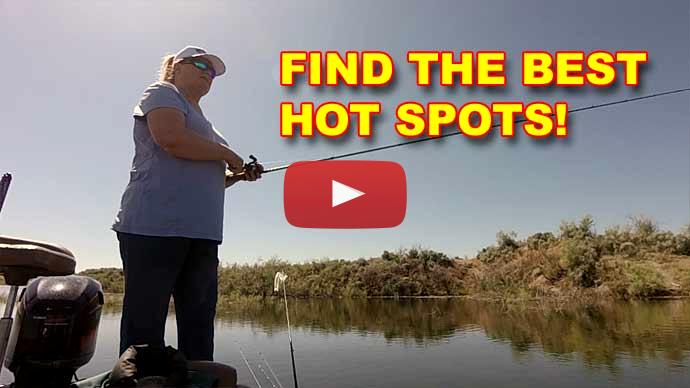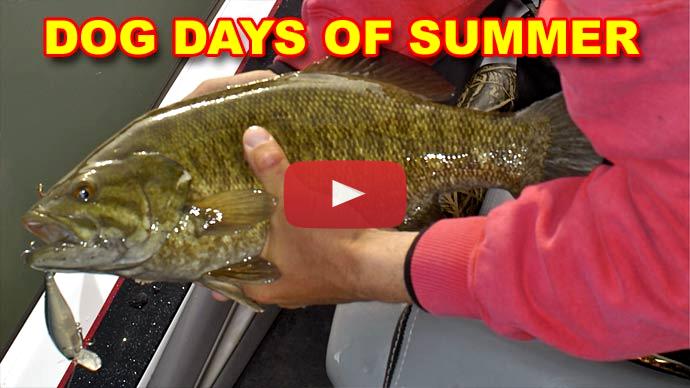As the heat of the summer approaches, using your electronics becomes increasingly important. Why? Because a lot of the bass population is in deeper water. Now, what I mean by deeper, is that in the springtime, the majority of the bass population is in less than 5 feet of water. Now, in the summertime, they're scattered. Yeah, you'll still find some of them shallow, absolutely. In less than 5 feet of water, they'll be up under docks, and they'll be in lily pad fields and whatnot. But a good chunk of the population will be deeper than 5 feet. That could be 7 feet of water, could be 8 feet of water, could be 15 feet of water. And still, there may be a bunch of bass that's even deeper than that. So, learning how to use your electronics to find areas that are gonna congregate the bass is going to be critical to your success. What you're looking for here are kind of the three things, the trifecta that go together to make a really good bass fishing location. And that is changes in your structure, your contour, and your bottom.
You're looking also for cover and composition changes, and you're also looking for the presence of bait fish. So, let's dive into that quickly. What that looks like on your depth finder, and how to find those? Starting with those contour changes. It's a drop in the bottom structure. What we're looking for here is you may be going along. It's completely flat. There's just nothing going on. Or a slow, gradual tapering drop into deeper water. And then you'll find a drop. It's just a sudden drop. It could only be 2 feet, 1 foot, maybe 3 feet, not a bunch, but it's going a long, and down it goes and comes back up, or just keeps on going. That little subtle change in an otherwise flat terrain. That can attract fish. So, that's what you want to pinpoint on your GPS and market.
How do you find those? Well, let's start off with something easy. Let's say a creek channel. Now, in a lot of reservoirs, they've been around for a long time. The creek channels have silted in, so they're not as defined as they used to be. You're not gonna have bottom, bottom, bottom, then [vocalization] creek channel, and then drop back up. Here's the other side of the creek. No, no, no, it's a lot subtler than that. It's like this, and then it kind of goes down a couple of feet, and then comes back up. It's a subtle change. But those can be hotspots. So, mark those when you find them. Also, let's just go with the creek channel analogy. Following that, a lot of creeks, they don't just run straight, they bend and wind and turn and curve. Those are the areas, those changes, that's what can attract bass.
So, you're looking for those creek bends. Especially if they swing up close to the bank. That's a really good spot because now the bass can sit there, and they can easily move up to shallow water, and back down without having to travel great distances. So, look for those channel swings on those bends, and mark them with your depth finder. The second thing you're looking for is cover and bottom composition. A lot of guys look for cover, but not the second one. So, let's get into this.
For cover, we're talking about things like weeds. And that'll show up in your depth finder, like strands, sometimes. Straight up and down strands that top off at a certain level, or sometimes they're a little bushy. You get the hard bottom, or you can tell where the bottom is, and something bushy on top of it, and then they top off at a certain level. And typically, they go for a long distance. It's not just a little ball.
But you can also find sunken brush piles. You can find logs, rocks, boulders, stumps, anything that sometimes, it looks like a little bump or anomaly on the bottom and otherwise flat terrain. That could be the type of cover that you're looking for. So, make sure you mark those, especially if they're near these channel...where the channel turns and curves. Those different anomalies.
What we're also looking for is bottom composition. What I mean by that, is the difference between a hard bottom and soft bottom, and all the variances in between. The best way to understand that... because it's hard, it can be really difficult to understand what you're looking at, and how soft or hard bottom, especially if you're looking at pebbles versus, you know, hard rock or chunk rock. Hard rock is hard. But chunk rock, gravel, you know, the difference between those, how can you tell?
Well, here's a little tip from your Uncle Glenn. Take your depth finder, if you're in that 15 feet, and set the range to 50 feet. I know that sounds crazy. "We're only in 15 feet, Glenn, why do you want to set to 50?" Okay, follow the bouncing ball. Now, what you'll find, sometimes, is you have the 15-foot level down at 30 feet, you might find another line. And sometimes at 40 feet, you may find another line. Now, it may be a really well-defined line at 30, and not so defined at 45, or you may not even see a line at 45. What you're seeing here... this is important. If it's a really hard bottom, the echo from the transducer, the ping, hits the bottom and bounces back up to the hull of your boat. And if it's a really strong signal, a strong echo with a hard bottom, it'll bounce off the hull of your boat and come back down, and bounce back up again.
Your transducer, what it's measuring is the distance in time from when the ping is sent to when it's returned. That's how it can measure how deep it is. Well, if the echo goes down, it comes back up and bounces down, and comes back up, it's measuring that second return, and will be exactly double the depth that you're at. In this instance, 30 feet. If you're at 20 feet, and you get that, you'll see the double echo at 40 feet, and so on. And if it's a super strong echo, in other words, a very hard bottom, you'll see a triple. A third echo at triple the depth. In this instance, we're talking 45 feet, right? So, this is really important. When you're learning your depth finder, you can tell the bottom composition, the variances between hard and soft bottom. Is it gravel? Is it pebble? Is it soft bottom? Is it mucky? And how mucky it is, and how soft it is, by looking at that second and third echo, and then the line that's at the actual depth. In this instance, 15 feet. Look at that line at 15 foot, and see what it looks like. And after a while, you'll get an idea of how to gauge what that bottom composition is just by looking at that bottom line without having to look at the double and triple echo. Great way to learn your electronics.
So, what's important about that is sometimes fish are, they want to be right up in rock bottom, they want to be in gravel, they want to be sometimes in soft bottoms. It just depends on the time of year, and what they're relating to. But that's really important to note because, sometimes, you can only find them on gravel bottom, and if there's gravel bottom doesn't exist, you're fishing empty water. So, a lot of guys miss that step when they're looking at the depth finder. So, pay attention to that bottom composition. It's just as important as the cover you're fishing, in my opinion. And then moving on to the third element, which is the presence of bait fish. Now, bait fish are gonna show up, not necessarily, in a ball. People talk about a ball of bait fish, but you're going to see a blob. Kind of an organized blob of fish, and sometimes it just looks as a little gray cloud or just a cloud, of sorts, on your depth finder, and that's gonna be bait fish.
And of course, wherever you find the bait fish, that's where the bass will be because they're always chasing bait fish around. So, if you're looking for really good spots during the summertime, you want to find that trifecta areas where you have a creek bend that's got cover on it with the right bottom composition, with the presence of bait fish. That is where bass are going to be. They will be located there. You find those areas, mark them on your GPS, find a few more like that, and then you can just go grocery shopping. You go spot to spot, to spot, eliminate all the other areas that aren't as productive, and you're gonna have yourself a great day.
Have some fun fishing this summer. Hope that helps. For more tips and tricks like this, visit BassResource.com.



